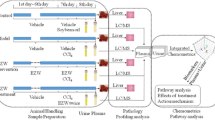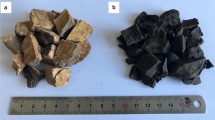Abstract
A comprehensive metabolomic strategy, integrating GC/MS and LC/MS data, had been developed to study the protection function of herbal medicine, Fructus Ligustri Lucidi, on mouse liver. Mouse plasma samples were analyzed by GC/MS and LC/MS in conjunction with multiblock multivariate analysis method, multiblock partial least squares discriminant analysis (MBPLS-DA), to supply more important and distinct information of metabolomic biomarkers. Then, the biological pathway analysis was carried out to help further understanding the mechanism of liver protection of Fructus Ligustri Lucidi.




Similar content being viewed by others
References
Pharmacopoeia of the People’s Republic of China (2010) Chinese Medical Science and Technology Press, Beijing, p 43
Yim TK, Wu WK, Pak WF et al (2001) Hepatoprotective action of an oleanolic acid-enriched extract of Ligustrum lucidum fruits is mediated through an enhancement on hepatic glutathione regeneration capacity in mice. Phytother Res 15:589–592
Yim TK, Ko KM (2001) Effects of Fructus Ligustri Lucidi extracts on concanavalin A-stimulated proliferation of isolated murine splenocytes. Pharmaceut Biol 39:146–151
Gao DW, Li QW, Li Y (2007) Antidiabetic potential of oleanolic acid from Ligustrum lucidum Ait. Can J Physiol Pharmacol 85:1076–1083
Tsai SJ, Yin MC (2008) Antioxidative and anti-inflammatory protection of oleanolic acid and ursolic acid in PC12 cells. J Food Sci 73:H174–H178
Dong XL, Zhao M, Wong KK et al (2012) Improvement of calcium balance by Fructus Ligustri Lucidi extract in mature female rats was associated with the induction of serum parathyroid hormone levels. Br J Nutr 108:92–101
Lindon JC, Holmes E, Nicholson JK (2004) Metabonomics: systems biology in pharmaceutical research and development. Curr Opin Mol Ther 6:265–272
Qiu Jane (2007) Traditional medicine: a culture in the balance. Nature 448:126–128
Qiu Jane (2007) ‘Back to the future’ for Chinese herbal medicines. Nat Rev Drug Discov 6:506–507
Wang M, Lamers R-JAN, Korthout HAAJ et al (2005) Metabolomics in the context of systems biology: bridging traditional Chinese medicine and molecular pharmacology. Phytother Res 19:173–182
Dai W, Wei C, Kong H et al (2011) Effect of the traditional Chinese medicine tongxinluo on endothelial dysfunction rats studied by using urinary metabonomics based on liquid chromatography–mass spectrometry. J Pharm Biomed Anal 56:86–92
Ni Y, Su M, Qiu Y et al (2007) Metabolic profiling using combined GC–MS and LC–MS provides a systems understanding of aristolochic acid-induced nephrotoxicity in rat. FEBS Lett 581:707–711
Chen M, Ni Y, Duan H, Qiu Y et al (2008) Mass spectrometry-based metabolic profiling of rat urine associated with general toxicity induced by the multiglycoside of Tripterygium wilfordii Hook. f. Chem Res Toxicol 21:288–294
Dunn WB, Ellis DI (2005) Metabolomics: current analytical platforms and methodologies. TrAC-Trend Anal Chem 24:285–294
Wangen LE, Kowalski BR (1989) A multiblock partial least squares algorithm for investigating complex chemical systems. J Chemom 3:3–20
Wold S, Martens H, Wold H (1984) In: MULDAST Proceedings edited by Wold S, Technical Report, Research Group for Chemometrics, Umea University, Sweden
McGregor J, Jaeckle C, Kiparissides C, Koutoudi M (1994) Process monitoring and diagnosis by multiblock PLS methods. Proc Syst Eng 40:826–838
Westerhuis J, Kourti T, MacGregor J (1998) Analysis of multiblock and hierarchical PCA and PLS models. J Chemom 12:301–321
Smilde AK, van der Werf MJ, Bijlsma S et al (2005) Fusion of mass spectrometry-based metabolomics data. Anal Chem 77:6729–6736
Nanji AA, Mendenhall CL, French SW (1989) Beef fat prevents alcoholic liver disease in the alcohol. Clin Exp Res 13:15–19
Pluskal T, Castillo S, Villar-Briones A et al (2010) MZmine 2: modular framework for processing, visualizing, and analyzing mass spectrometry-based molecular profile data. BMC Bioinforma 11:395–405
Wold S, Sjöström M, Eriksson L (2001) PLS regression: a basic tool of chemometrics. Chemom Intell Lab Syst 58:109–130
Perez-Enciso M, Tenenhaus M (2003) Prediction of clinical outcome with microarray data: a partial least squares discriminant analysis (PLS-DA) approach. Hum Genet 112:581–592
Ramsay JO, Ten Berge JMF, Styan GPH (1984) Matrix correlation. Psychometrika 49:403–423
Robert P, Escoufier Y (1976) A unifying tool for linear multivariate statistical methods: the RV-coefficient. Appl Statist 25:257–265
Smilde AK, Westerhuis JA, De Jong S (2003) A framework for sequential multiblock component methods. J Chemom 17:323–337
Bylesjö Max, Eriksson Daniel, Sjödin Andreas et al (2005) MASQOT: a method for cDNA microarray spot quality control. BMC Bioinforma 6:250–259
Fonville JM, Richards SE, Barton RH et al (2010) The evolution of partial least squares models and related chemometric approaches in metabonomics and metabolic phenotyping. J Chemom 24:636–649
Bro R, Smilde AK (2003) Centering and scaling in component analysis. J Chemom 17:16–33
Bando K, Kunimatsu T, Sakai J et al (2011) GC-MS-based metabolomics reveals mechanism of action for hydrazine induced hepatotoxicity in rats. J Appl Toxicol 31:524–535
Dawson RM (1955) The role of glycerylphosphorylcholine and glycerylphosphorylethanolamine in liver phospholipid metabolism. Biochem J 59:5–8
Amathieu R, Nahon P, Triba M et al (2011) Metabolomic approach by 1H NMR spectroscopy of serum for the assessment of chronic liver failure in patients with cirrhosis. J Proteome Res 10:3239–3245
Stoll B, Burrin D, Henry J et al (1998) Dietary amino acids are the preferential source of hepatic protein synthesis in piglets. J Nutr 128:1517–1524
Yang L, Xiong A, He Y et al (2008) Bile acids metabonomic study on the CCl4- and alpha-naphthylisothiocyanate-induced animal models quantitative analysis. Chem Res Toxicol 21:2280–2298
Nicholson JK, Lindon JC, Holmes E (1999) ‘Metabonomics’: understanding the metabolic responses of living systems to pathophysiological stimuli via multivariate statistical analysis of biological NMR spectroscopic data. Xenobiotica 29:1181–1189
Acknowledgments
The study has been supported by the foundation (Grant No. 81001599) from National Natural Science Foundation of China, the Doctoral Foundation (Grant No. 20103237120010) of Youth Scholars of Ministry of Education of China and the Open Project of National First-Class Key Discipline for Science of Chinese Materia Medica, Nanjing University of Chinese Medicine (Grant No. 2011ZYX1-009).
Author information
Authors and Affiliations
Corresponding authors
Rights and permissions
About this article
Cite this article
Yao, W., He, M., Jiang, Y. et al. Integrated LC/MS and GC/MS Metabolomics Data for the Evaluation of Protection Function of Fructus Ligustri Lucidi on Mouse Liver. Chromatographia 76, 1171–1179 (2013). https://doi.org/10.1007/s10337-013-2519-2
Received:
Revised:
Accepted:
Published:
Issue Date:
DOI: https://doi.org/10.1007/s10337-013-2519-2




